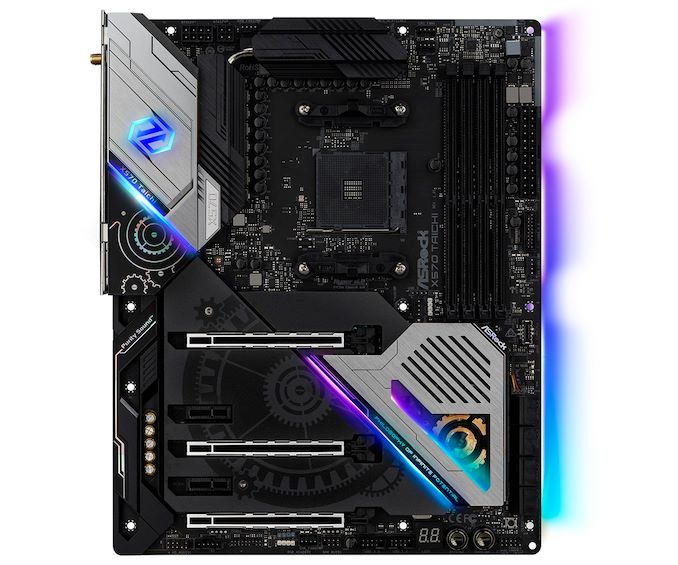The AMD X570 Motherboard Overview: Over 35+ Motherboards Analyzed
by Gavin Bonshor on July 9, 2019 8:00 AM ESTASRock X570 Taichi
Moving a step down the product stack from the X570 Aqua is the ASRock X570 Taichi which includes a new RGB inspired design, and shifts away from the usual black and white Taichi theme. While still targetted at premium users and enthusiasts, the ASRock X570 Taichi is representative of one of its most well-known lines which in previous generations has combined quality, performance, and a solid feature set at a reasonable price point. The ASRock X570 Taichi also uses its fabled signature cogwheel design across the board covers and integrates ARGB into multiple areas.
The ASRock X570 Taichi redefines the range and marks a change in aesthetics across the entirety of the board. On the majority of the board is its memorable cogwheel design is still a main element of the design but it now includes black heatsink armor around the PCIe slot area. The X570 chipset is actively cooled by a fan, mainly due to the X570 chipsets tendency to run warmer than previous generations. On the rear panel cover as with the chipset heatsink is ARGB for users looking to make a visual statement with their system. The X570 Taichi uses a 14-phase power delivery and has one 8-pin and one 4-pin 12 V CPU power inputs.
On the X570 Taichi is three full-length PCIe 4.0 slots operating at x16, x8/x8, and x8/x8/x4, with two PCIe 4.0 x1 slots. Underneath the heatsink armor is three PCIe 4.0 M.2 slots, while the board also supports up to eight SATA devices. For users looking for Thunderbolt connectivity, a Thunderbolt AIC 5-pin connector is present, but support is limited to ASRock's separately supplied AIC card. A total of four memory slots with support for DDR4-4666 are present, with a maximum supported capacity of up to 128 GB.
On the rear panel is a single Intel I211-AT Gigabit port, and also includes the new 802.11ax Killer AX1650 Wi-Fi 6 wireless adapter. There are three USB 3.1 G2 Type-A, a single USB 3.1 G2 Type-C, and four USB 3.1 G1 Type-A ports. An HDMI video output is present for users looking to use the integrated graphics on Ryzen APUs, while there's five 3.5 mm color coded audio jacks and S/PDIF optical output which is powered by a Realtek ALC1220 HD audio codec. For legacy users, a PS/2 combo port is featured, along with a BIOS Flashback button and a button to reset the CMOS.
The ASRock X570 Taichi has an MSRP of $300 and represents one of its most recognisable ranges for the last decade. Users looking for a mid-range option with plenty of features including triple PCIe 4.0 x4 M.2 slots, plenty of SATA, and solid power delivery will be hard pushed to find a better board in its price range.












225 Comments
View All Comments
Supercell99 - Tuesday, July 9, 2019 - link
I also expected benchmarks and a naked woman serving me a beer.haukionkannel - Wednesday, July 10, 2019 - link
You did not get that? That is really strange... I was sure that that was the basic service in here!;)
Gastec - Wednesday, July 10, 2019 - link
I had a dream last night about a woman, she was serving me...benchmarks :)Duncan Macdonald - Tuesday, July 9, 2019 - link
Why is the DDR4 memory speed being shown as a feature of the chipset? The memory is directly driven by the CPU not the chipset and as such the memory speed is independent of the chipset.Dug - Tuesday, July 9, 2019 - link
The motherboard still has work to do and is what supports the faster speed memory. Just because the cpu allows it, doesn't mean it will work without the correct chipset.thomasg - Tuesday, July 9, 2019 - link
The chipset has nothing to do with it, it has no relation to RAM clock and is exclusively driven by the PCIe clock, which is unrelated.The mainboard itself has the traces and therefore the manufacturer is expected to provide appropriate timing sequences to load into the CPU, which again, is not done on the chipset.
There's no reason a mainboard manufacturer couldn't support faster RAM on any older, compatible board (provided they do a firmware update and the board is designed well enough), a chipset upgrade is not required.
Death666Angel - Wednesday, July 10, 2019 - link
"the board is designed well enough" There is the catch. It might be that Ryzen being the first of its kind meant that many 3xx boards were designed poorly.First test I've seen is TPUs R9 3900x on a ASUS Prime B350 Plus which they claim ran at 3200CL14, but only after setting it to 2666MHz first and letting it train the memory. But it's an encouraging result.
Dug - Tuesday, July 9, 2019 - link
I'm interested in seeing what coolers will fit on the mITX boards. Specifically ASRock X570 Phantom Gaming-ITX TB3.It looks like some of these boards might be limited due to high heatsinks and fans on the motherboards.
Mikewind Dale - Tuesday, July 9, 2019 - link
Could we please have a comparison table? 35 pages is too many read. It would be useful to have a comparison table so that I can narrow down the several motherboards I am interested in, and then compare their prices.halcyon - Tuesday, July 9, 2019 - link
A summary table of features would indeed be very helpful. Way too many boards and pages...